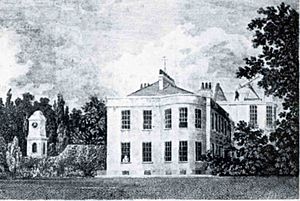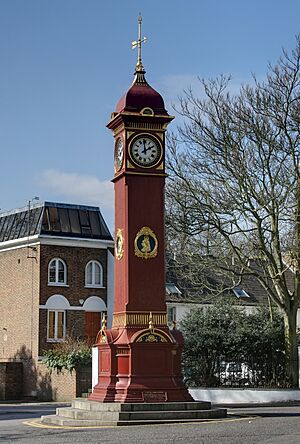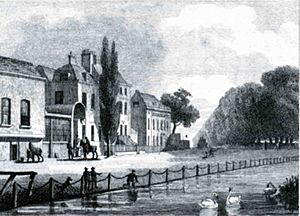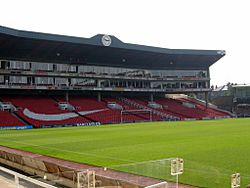Highbury facts for kids
Quick facts for kids Highbury |
|
|---|---|
 Highbury House, c. 1800 |
|
| Population | 26,664 (2011 Census. Highbury East and West Wards) |
| OS grid reference | TQ319854 |
| London borough | |
| Ceremonial county | Greater London |
| Region | |
| Country | England |
| Sovereign state | United Kingdom |
| Post town | LONDON |
| Postcode district | N5 |
| Dialling code | 020 |
| Police | Metropolitan |
| Fire | London |
| Ambulance | London |
| EU Parliament | London |
| UK Parliament | |
| London Assembly |
|
Highbury is a lively area in North London, located within the London Borough of Islington. This historic place got its name because its main house was built on a hill. "Highbury" means "high manor house."
Long ago, Highbury was owned by a person named Ranulf. His land included all the areas north and east of Canonbury and Holloway Roads. The very first manor house was located near what is now Hornsey Road. Later, in 1271, a new manor house was built on a hill to the south-east. This new location gave the area its name, Highbury.
Some people believe that a Roman army might have used the Highbury Manor site as a summer camp. When a new Highbury House was being built in 1781, workers found old tiles. These tiles might have been from Roman or Norman times, but sadly, they have since been lost.
Contents
Highbury's Early History
Who Owned Highbury Manor?
Over time, Highbury Manor came into the hands of Alicia de Barrow. In 1271, she gave it to a special group called the Priory of St John of Jerusalem. This group was also known as the Knights Hospitallers in England. These wealthy knights built Highbury manor as a large stone country home, complete with a farm and a barn.
What Happened During the Peasants' Revolt?
In 1381, a big event called the Peasants' Revolt took place. A leader named Jack Straw led a huge crowd of 20,000 people. They were very angry about how rich and proud the Knights Hospitallers were. Because of this, they completely destroyed the manor house.
The leader of the Knights Hospitallers at that time, Robert Hales, had tried to hide in the Tower of London. But he was caught and executed. Jack Straw and some of his followers used the ruined manor as a temporary base. For the next 500 years, the destroyed manor was known as Jack Straw's Castle. It's important not to confuse this with another famous place called Jack Straw's Castle in Hampstead, which was a pub named after the same rebel leader.
Highbury House: From Manor to Modern Flats
How Did Highbury House Change Hands?
The land of Highbury remained with the Knights of St John until King Henry VIII took it in 1540. After that, it belonged to the Crown (the King or Queen) until the Parliament started selling it in the 1600s.
A property developer named John Dawes bought the site of Jack Straw's Castle and about 247 acres (1 square kilometer) of land around it. In 1781, he built Highbury House on the very spot where the old Highbury Manor had stood. It cost him £10,000, which was a huge amount of money back then!
Over the next 30 years, new owners, Alexander Aubert and then John Bentley, made the house even bigger. They added a large observatory (for looking at stars) and beautiful gardens.
What Happened to Highbury House Later?
The land around Highbury House began to be sold off in 1794. By 1894, Highbury House itself and its remaining grounds became a school. Finally, in 1938, Highbury House was torn down. Today, a block of flats called Eton House stands on that site, built in 1939.
Highbury Barn: A Popular Entertainment Spot
After the manor house was destroyed in 1381, the farm and barn remained. They were located on the east side of a path that led south. In 1740, a small place selling ale and cakes opened in the Barn.
How Did Highbury Barn Become Famous?
In 1770, William Willoughby took over Highbury Barn and made it much more popular. He made it bigger and added more things to do. He even took over land from the farm next door. He created a bowling green, areas for a game called trap-ball, and lovely gardens.
Highbury Barn became one of the most popular places in London for entertainment. It could host dinners for 2,000 people, concerts, and dancing.
Why Did Highbury Barn Close?
By the mid-1800s, Highbury Barn was a huge success. In 1854, events included the balloon flights of Charles Green. By 1865, it had a giant dancing platform, a rebuilt theater, high-wire acts, pantomime, music hall shows, and even the original Siamese twins.
However, the Barn became too popular. After a riot in 1869, local people complained about the noisy crowds. This led to a court case, and in 1871, the authorities took away the Barn's dancing license.
Highbury's Growth as a Residential Area

By 1794, Highbury had Highbury House, Highbury Hill House, Highbury Barn, and two gated streets called Highbury Terrace and Highbury Place. These streets were built on land rented from John Dawes.
There was a plan to create a huge park called Albert Park, covering 250 acres (1 square kilometer). Instead, a smaller 27.5-acre (111,000 square meter) area, which is now Highbury Fields, was saved in 1869. Also, the 115-acre (465,000 square meter) Finsbury Park was created. The rest of the area was then developed with homes.
When Did Highbury Get More Houses?
Most of Highbury's development happened in two main stages. Until the 1870s, many large Italian-style villas (big houses) were built, mostly in the southern part of Highbury. After that, more houses were built closer together, especially terraced houses (houses joined in a row), mainly in the north of Highbury. More homes continued to be built until 1918.
How Did Highbury Change After World War II?
Highbury was bombed during the Blitz and later by V-1 flying bombs during World War II. On June 27, 1944, a V-1 bomb destroyed Highbury Corner, killing 26 people and injuring 150. Highbury Corner had a grand station and hotel, which were damaged. The main station building was used until the 1960s when it was pulled down to build the Victoria Line. A red plaque on a building wall remembers this event.
After the war, many bombed buildings in Highbury were replaced. New council housing (homes built by the local government) was also provided. Some old villas that hadn't been updated were also torn down for more council housing. Some buildings had to be "listed" (protected by law) to save them.
In the 1980s, property prices went up. The council started selling some of the grand villas to private developers. These developers had the money to restore the old buildings. For example, in 2004, Islington council sold four buildings on Highbury New Park for £1 million each.
The Highbury Community Association (HCA) was started in 1997. This group works to represent the people and businesses in Highbury and nearby areas. They campaign on many issues related to living and working in this part of North London.
In the 1920s, Catholic residents in Highbury needed a place to worship. So, St Joan of Arc's church was built on Kelross Road. It was one of the first churches dedicated to the saint, who became a saint in 1920. The church was soon made bigger. After the war, even more Catholic residents moved in, so a new, larger church was needed. The new St Joan of Arc church opened on September 23, 1962, on Highbury Park.
Arsenal Stadium: A Football Landmark
In 1913, the football club Woolwich Arsenal F.C. moved to Highbury. They dropped "Woolwich" from their name. Their chairman, Sir Henry Norris, rented part of the grounds of St John's Hall for £20,000. The new Arsenal Stadium (also known as Highbury) was built there.
St John's Hall was originally called Highbury College. It was built in 1825 and was a grand building, similar to the British Museum. St John's Hall burned down in 1946 and was replaced by a block of flats.
The football club became very successful. By 1925, they had bought the land. Arsenal's success made Highbury famous. In 2006, the club moved to Ashburton Grove, which is also in Highbury.
The old stadium was turned into a fancy housing complex called Highbury Square. The two main stands, which were protected historical buildings, were turned into apartments. This kept their original outside look. The other stands were torn down to make way for new apartment blocks. The football pitch was turned into a garden, with a private gym and swimming pool underneath it. Today, homes around the old Highbury stadium are very popular, and apartments inside the stadium start at £300,000.
Highbury in Books and Films
Highbury has been a setting or inspiration for many creative works:
- For 40 years starting in 1965, Highbury New Park was home to Wessex Studios. This is where famous bands like Queen, Genesis, the Rolling Stones, the Sex Pistols, and The Clash recorded some of their best-known albums. The studio was created by Sir George Martin, who produced The Beatles. The building is now apartments called "The Recording Studio."
- Highbury was also home to Highbury Studios, a film, TV, and recording studio. It started as a music school in 1890 and became a recording studio in 1926. In 1933, it became Highbury (film) Studios. The studios closed in 1960 and are now a block of flats.
- As of 2019, Highbury is home to the London Screen Academy (LSA). This college teaches young people skills for working behind the camera in films and TV. Famous film producers helped start LSA.
- The book A London Family 1870–1900 by Molly Hughes mentions Highbury New Park.
- The book The Rescue Man by Anthony Quinn has scenes at Highbury Corner after the V-1 bomb attack on June 27, 1944.
- The film Killing Her Softly was partly filmed on Highbury New Park.
- The film Fever Pitch was filmed around the Arsenal stadium and Highbury Hill.
- The film Four Weddings and a Funeral starts with Hugh Grant trying to get a taxi at Highbury Corner. It ends in front of the houses near Highbury Fields.
- The film The Arsenal Stadium Mystery was filmed in and around the Arsenal stadium.
- The poem Summoned by Bells by John Betjeman mentions Highbury several times, including St Saviours Church.
- The funny character Mr. Bean lives in Highbury.
- Writer Alan Moore recorded a special performance about Highbury called 'The Highbury Working'.
- In the early 1970s, the BBC filmed a drama called "The House on Highbury Hill."
- Highbury is mentioned in Vanity Fair by William Makepeace Thackeray.
- The novel Emma by Jane Austen is set in a village called Highbury. However, Austen's Highbury is a made-up village in Surrey, not the Highbury in London.
- Highbury is mentioned in T.S. Eliot's famous poem The Waste Land.
- Andrea Levy's book Every Light in the House Burnin' is set in Highbury.
Highbury's Location
Highbury is located about 4.4 miles (7.1 kilometers) north of Charing Cross, which is a central point in London. The area covers about 500 acres (2 square kilometers).
Getting Around Highbury
Here are the closest train and tube (underground) stations in and around Highbury:
- Arsenal tube station
- Canonbury railway station
- Drayton Park railway station
- Finsbury Park station
- Holloway Road tube station
- Highbury & Islington station





